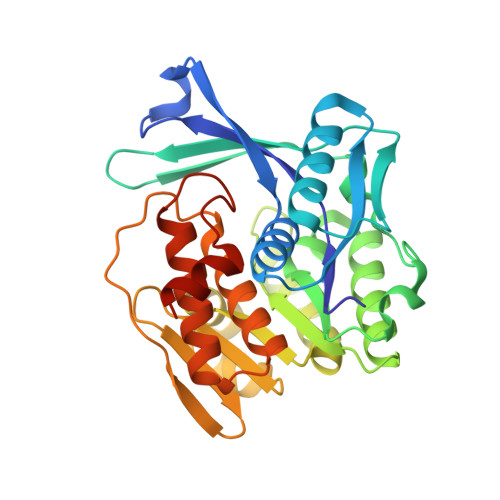Structure of Thermus Thermophilus 2-Keto-3-Deoxygluconate Kinase: Evidence for Recognition of an Open Chain Substrate
Ohshima, N., Inagaki, E., Yasuike, K., Takio, K., Tahirov, T.H.(2004) J Mol Biol 340: 477
- PubMed: 15210349
- DOI: https://doi.org/10.1016/j.jmb.2004.04.074
- Primary Citation of Related Structures:
1V19, 1V1A, 1V1B, 1V1S - PubMed Abstract:
2-Keto-3-deoxygluconate kinase (KDGK) catalyzes the phosphorylation of 2-keto-3-deoxygluconate (KDG) to 2-keto-3-deoxy-6-phosphogluconate (KDGP). The genome sequence of Thermus thermophilus HB8 contains an open reading frame that has a 30% identity to Escherichia coli KDGK. The KDGK activity of T.thermophilus protein (TtKDGK) has been confirmed, and its crystal structure has been determined by the molecular replacement method and refined with two crystal forms to 2.3 angstroms and 3.2 angstroms, respectively. The enzyme is a hexamer organized as a trimer of dimers. Each subunit is composed of two domains, a larger alpha/beta domain and a smaller beta-sheet domain, similar to that of ribokinase and adenosine kinase, members of the PfkB family of carbohydrate kinases. Furthermore, the TtKDGK structure with its KDG and ATP analogue was determined and refined at 2.1 angstroms. The bound KDG was observed predominantly as an open chain structure. The positioning of ligands and the conservation of important catalytic residues suggest that the reaction mechanism is likely to be similar to that of other members of the PfkB family, including ribokinase. In particular, the Asp251 is postulated to have a role in transferring the gamma-phosphate of ATP to the 5'-hydroxyl group of KDG.
Organizational Affiliation:
Highthroughput Factory, RIKEN Harima Institute, 1-1-1 Kouto, Mikazuki-cho, Sayo-gun, Hyogo 679-5148, Japan.















